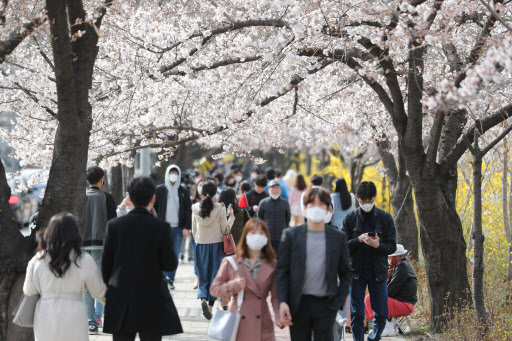With no end in sight in the global coronavirus outbreak, South Korea is pondering sustainable ways of continuing the quarantine system while also allowing for a return to normal.
The government said Monday it will launch a body encompassing public and private experts this week to devise guidelines on how people should go about their day while still helping to bring the spread of the virus under control.
“The long-term goal is to control the size of infections to the level where hospitals and medical workers can cope with the situation until the pandemic comes to an end with the development of vaccines or treatment,” said Kim Gang-lip, vice health and welfare minister, at a briefing Monday.
The guidelines would include tips for Koreans on how to safely carry out their daily activities at home, school, work, restaurants and on public transport -- from social distancing guidelines to personal hygiene rules -- to minimize risks of contracting the virus and infecting others.
For now, it is not yet decided when and how the country should return to normal, with what officials here describe as the “everyday-life quarantine” practices.
Currently, strict “social distancing” rules are in place to bring down the number of new infections.
Composed of medical professionals, quarantine experts, government officials and representatives from labor, business and civic society, the envisioned body will work on eased but still effective guidelines, as well as when to introduce them and how to encourage the public to follow them.
The move comes amid growing fatigue among the public over prolonged social distancing practices.
Despite the government’s urge for stepped-up social distancing through April 5, riversides, parks and mountains were packed with Koreans seeking to enjoy the spring breeze over the weekend.
Kim Min-jo, a 32-year-old office worker, spent the day picnicking along the Han River on Sunday, following a few weeks of being stuck at home with many of his social gatherings on hold.
“It is true I grew tired of watching news about the coronavirus and loosened up a little bit because there is no one around me who has been infected with the virus,” Kim said. “Still, I try to avoid going to indoor, enclosed places.”
“Even when we return to normal, I would feel safer if the government could put certain rules in force, restricting mass gatherings indoors, for example,” he said.
For the past month, the government has asked the public to stay at home as much as possible and to refrain from gathering in large groups. Religious facilities, indoor sports facilities and nightclubs have been subjected to tougher quarantine rules as part of efforts to stop small-scale clusters of infections from occurring.
Child care centers, kindergartens and schools are closed nationwide, with the government widely expected to further delay their reopening, currently set for April 6.
South Korea has seen the number of new infections stabilize over the past few weeks from the peak of 909 reported on Feb. 29. The number of those making full recoveries exceeds that of new infections these days, with the recovery rate so far standing at 54.1 percent.
Concerns, however, persist that the country not return to a ”precoronavirus normal.“ The country should adapt to a new, pandemic-era normal, experts say.
“The daily quarantine system is a totally new concept, with its definition, goal and content to be drawn up,” said Eom Jung-sik, a professor of infectious disease at Gachon University Gil Hospital.
“If the daily quarantine system means loosening up on social distancing and returning to the (precoronavirus) normal, it would inevitably mean a rise in infections. A public consensus should be made on to what extent the society is willing to cope with further transmission of the virus.”
(
laeticia.ock@heraldcorp.com)








![[Today’s K-pop] Blackpink’s Jennie, Lisa invited to Coachella as solo acts](http://res.heraldm.com/phpwas/restmb_idxmake.php?idx=644&simg=/content/image/2024/11/21/20241121050099_0.jpg)